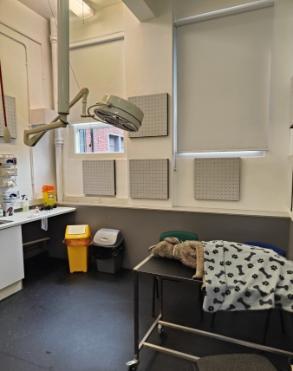
Simulated Learning Environments in Veterinary Education
|
Title of case study |
Simulated Learning Environments in Veterinary Education
|
|
School/Subject: |
School of Biodiversity, One Health & Veterinary Medicine – Veterinary Medicine |
|
Lecturer(s): |
Emilie Law, Gemma Masterton, Lorna Chambers, Maureen Carnan |
|
Course: |
Veterinary Medicine & Surgery (D100/210) |
|
Student Level: |
Undergraduate and postgraduate |
|
Class size:
|
Approximately 130 students in each year group, Maximum 10 students per simulation session |
|
|
Brief summary of the case study: We have introduced an educational simulation to veterinary students as part of their teaching during the last year of the BVMS programme. Students are given the opportunity to take part in a simulation involving a challenging ‘high stakes’ clinical scenario. As part of this teaching intervention, we are exploring the impact of safe learning spaces & psychological safety in simulated learning environments.
Objectives
There is growing evidence of the benefits of simulation in higher education & we were keen to introduce this as an active learning method in our programme. We were also excited to see how our students would react to their first experience of a simulated-learning environment.
We wanted to create an opportunity for our students to practice approaching a ‘high stakes’ challenging clinical scenario involving client communication in a safe, risk-free environment. The simulation enables students to synthesise their practical, communication and interprofessional skills in an authentic, yet supportive environment prior to encountering these scenarios on work-based learning placements and as new graduate vets.
We are always looking for ways we can encourage students to develop interprofessional skills on our programme. Our simulated scenario involves a professional actor as a client, a registered veterinary nurse (RVN) and a vet (student role); giving students the opportunity to recognise and utilise the nurses’ role to help them work through the scenario. Working collaboratively as vets and nurses in this way is a realistic reflection of working in veterinary practice and a core skill often not addressed directly in our practical teaching on the BVMS programme which focuses more on the individual veterinary undergraduates’ skill development.
We also felt that these 'high stakes’ scenarios would likely benefit from an opportunity to engage in group discussion with peers and experienced staff in a safe space. This is facilitated in a guided debrief after the simulation.
What was done?
Structure:
- We ran a total of 6 x 1-hour sessions open to a maximum of 10 students/session
- Staff - 3 lecturers were present during the session. All staff had professional experience of the simulated scenario – please note: we feel this session could also be run with 1-2 staff members once experienced.
- 1 professional actor from Birdsong Communication Skills Ltd – to act as the client (prior training/familiarisation of the scenario is required, provided in the form of written documentation: scripting of the scenario and session plan)
- 1 veterinary nurse/RVN – to provide support to the student within the simulation
- Students were invited to sign up via the Moodle Scheduler plugin – please note this may change with future Moodle upgrades.
- Introductory information about the simulations was provided to students via Moodle, including photographs of the simulation environment, intended learning outcomes and session plan outline.
- Sessions were offered to year 5 students during an induction week prior to embarking on their work-place based rotations. They had received all their formal education and training over years 1 to 4 of the BVMS programme.
- Sessions were timetabled so as not to clash with other events.
Location:
- The simulation took place in one of our purposely designed ‘consultation rooms’ - a space that is authentic and reflective of the environment this scenario would likely take place in the real world.
- An observation/debrief space – this was created in a room next door.
Equipment:
- A video camera with WiFi capability/livestream software in the simulation room – e.g Meeting OWL.
- TV screen and speakers for livestream in the observation/debrief space.
- Whiteboard and whiteboard markers in the observation/debrief space.
- Specific to this scenario – we had a model dog capable of receiving an injection, tissues, seats for the actor/vet, mock paperwork etc. We used equipment that was familiar to students from previous practical teaching.
What worked well?
We observed that students were enthusiastic about the new opportunity to take part in a simulation. Students commented that they recognised the benefit of practising the scenario in a safe environment and that the professional actor and nurse added to the sense of realism. Feedback suggests that students also placed a lot of value on the interactions and discussion that was generated between peers and staff during the debrief. The debrief was structured by asking participants (students and staff) to reflect on the experience and compile a list of their ‘triumphs’ and ‘challenges’ from engaging in the simulation. This helped guide the discussion.
Benefits
|
Students |
Staff |
|
|
|
Challenges
|
Students |
Staff |
|
|
|
What did you learn?
We have learned that this type of learning lends itself well to our approach to teaching on the veterinary programme. It has been really enjoyable to create and see the simulated scenario play out with students. Many of our students are still unfamiliar with simulation-based education and it would be great to increase awareness and support for this approach to learning on the programme.
In the future, we would like to be able to offer all students the opportunity to take on the ‘vet role’ in the simulation. We could achieve this by running more sessions with smaller group numbers or allocating more time within the session although we acknowledge this would present a challenge in terms of the availability of staff & space.
Recognising that not all students may feel comfortable taking part in the simulation as the ‘vet role’, we will also review how to reinforce the value of the ‘observer’ role. We have considered giving students in this role a more active part to play such as guiding reflection or scoring feedback.
We did experience some technology issues with sound. We feel a larger screen & clearer audio for ‘observation room’ would enhance the observer experience.
We would like to continue to develop our own skills in guiding ‘debriefs’ and recognise this as an area for our own personal development.
What advice would you give to others?
We would recommend starting the process of building a simulation for your course by identifying common knowledge gaps your students experience and/or opportunities for the synthesis of theoretical concepts and practical skills or attributes. If your students are expected to do any workplace-based learning, then simulated scenarios could be a great opportunity to prepare them for this transition. We would also recommend consulting others, including your students, in the design process of your simulation. We have included a number of useful resources & relevant literature on simulation and role play in higher education in the ‘References’ section below.
Simulation-based education may be a completely new experience for your students (it was for ours!). This could be nerve-wracking for them if they don’t know what to expect and might prevent them from wanting to volunteer to take part. Any supporting resources you can create to ensure the aims of the experience and learning outcomes are transparent may improve student engagement.
It helps to think of a contingency plan – what are you going to do if no one volunteers to take part? How can you encourage participation whilst still creating a psychologically safe & supportive environment? For instance, is it possible to split the roles so students could take part in pairs/small groups?
The power of the debrief – make sure to allocate sufficient time for this and think of a structure to help guide the discussion.
Supporting references
Chernikova, O., Heitzmann, N., Stadler, M., Holzberger, D., Seidel, T., & Fischer, F. (2020) Simulation-Based Learning in Higher Education: A Meta-Analysis. Review of Educational Research, 90(4), 499-541. https://doi.org/10.3102/0034654320933544 (Original work published 2020)
Hardie, P., O’Donovan, R., Jarvis, S. et al. (2022) Key tips to providing a psychologically safe learning environment in the clinical setting. BMC Med Educ 22, 816. https://doi.org/10.1186/s12909-022-03892-9






